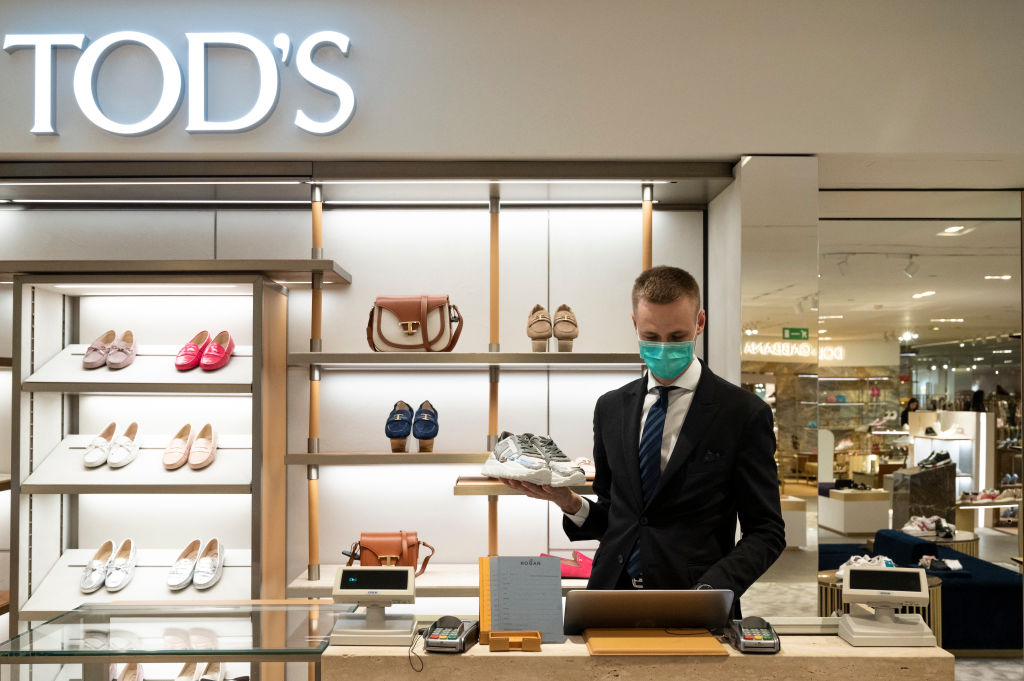
After the coronavirus outbreak forced Chinese fashion designers, buyers and other industry insiders to skip Milan’s Fashion Week in late February, the Camera Nazionale della Moda Italiana, or National Chamber of Italian Fashion, launched a campaign to demonstrate solidarity: “China, we are with you.” The slogan turned out to be prophetic. By the end of fashion week, Italy was facing a coronavirus outbreak of its own, and Milan’s typically bustling streets were eerily empty. Models posted Instagram selfies in masks, fashion magazines asked their employees to work from home, and Giorgio Armani held his women’s Fall/Winter 2020/2021 fashion show in an empty theater.
The coronavirus outbreak is likely to be a nightmare for Italy’s $100 billion-plus fashion industry, says Carlo Capasa, the head of the National Chamber of Italian Fashion. The country’s fashion companies were expecting a strong start to 2020, but are now struggling to cope with supply chain issues and weak demand, especially in China, the heart of the coronavirus outbreak. “For sure, we think the first six months of 2020 are going to be bad,” Capasa says.
What’s happening to Italy’s fashion industry is likely a preview of the coronavirus’ impact on the global economy more broadly. Companies in a wide range of industries are dependent on China as both a manufacturing behemoth and billion-plus-consumer market. But as life in some parts of the country comes to a near-standstill in the face of the outbreak, that reliance looks more and more like a weakness.
Like many other industries, the fashion world has long embraced China as a source of cheap manufacturing — the country is by far the world’s largest producer of textiles, and it produces many of the other elements that go into clothes, from buttons to zippers to thread. “The vast majority of certain products are only done in China,” says Gary A. Wassner, the CEO of Hildun Corporation and the chairman of Interluxe. “We became very dependent, and we allowed it to happen because it was cost-efficient, but that’s not the only thing to consider.”
That dependency is now proving disastrous. As workers in China are being kept home amid fears of spreading the coronavirus, it’s causing delays in the manufacturing supply chain. Those delays are particularly problematic in the fashion business because clothes are sold in seasons, experts say. Companies that receive raw materials like textiles late may need to mark down products or charge manufacturers for delays. Wassner adds that companies which sell only “private labels,” or one signature brand, may be especially vulnerable because it will be harder for them to switch suppliers. The trend-focused fast fashion business will also be in peril, says Margaret Bishop, an expert in apparel and textile supply chains. “The timeline from design to delivery in fast fashion has been very significantly compressed, so there’s not a lot of extra time that if there’s a delay of some sort, you’ve got some margin built in,” she says.
Sign up for our daily coronavirus newsletter by clicking on this link, and please send any tips, leads, and stories to virus@time.com.
The supply chain issues affecting fashion companies are also affecting other industries that are reliant on Chinese manufacturing, like the automotive and technology businesses. Pierre Haren, CEO of fintech start-up Causality Link, says consumers may soon start to see less variety on store shelves as companies concentrate their available production on products they already know to be best-sellers, and predicts there could be supply shortages as early as mid-March.
The fashion industry and other sectors are also facing big challenges from the other end of the production chain: consumer demand. Pauline Brown, the former chairman of North America at LVMH, says the luxury market is already starting to see a “fairly severe” effect due to the virus, especially as Chinese shoppers stop traveling to make big-ticket purchases in cities like New York and Paris. Brown says that, as consumers become focused on their health, they’re less likely to shop for luxury goods.
“The Chinese have been the single biggest driver in luxury and fashion in the last 10 years,” says Brown. “They comprise about one-third of all purchases of luxury, but they are more than 70% of the annual growth in luxury consumption. So there has been a disproportionate reliance for quite a few years in that consumer.”
Fashion companies that were fairly healthy before the coronavirus outbreak will likely recover from any disruptions, says Brown. But she thinks firms that were already struggling will find it more difficult to bounce back — and that will likely be true of companies in other sectors, too. “Consumers are pretty unforgiving,” she says. “As they say, you know when the tide goes out you can see who’s naked, and the tide’s going to definitely go out.”
More Must-Reads From TIME
- The 100 Most Influential People of 2024
- Coco Gauff Is Playing for Herself Now
- Scenes From Pro-Palestinian Encampments Across U.S. Universities
- 6 Compliments That Land Every Time
- If You're Dating Right Now , You're Brave: Column
- The AI That Could Heal a Divided Internet
- Fallout Is a Brilliant Model for the Future of Video Game Adaptations
- Want Weekly Recs on What to Watch, Read, and More? Sign Up for Worth Your Time
Contact us at letters@time.com